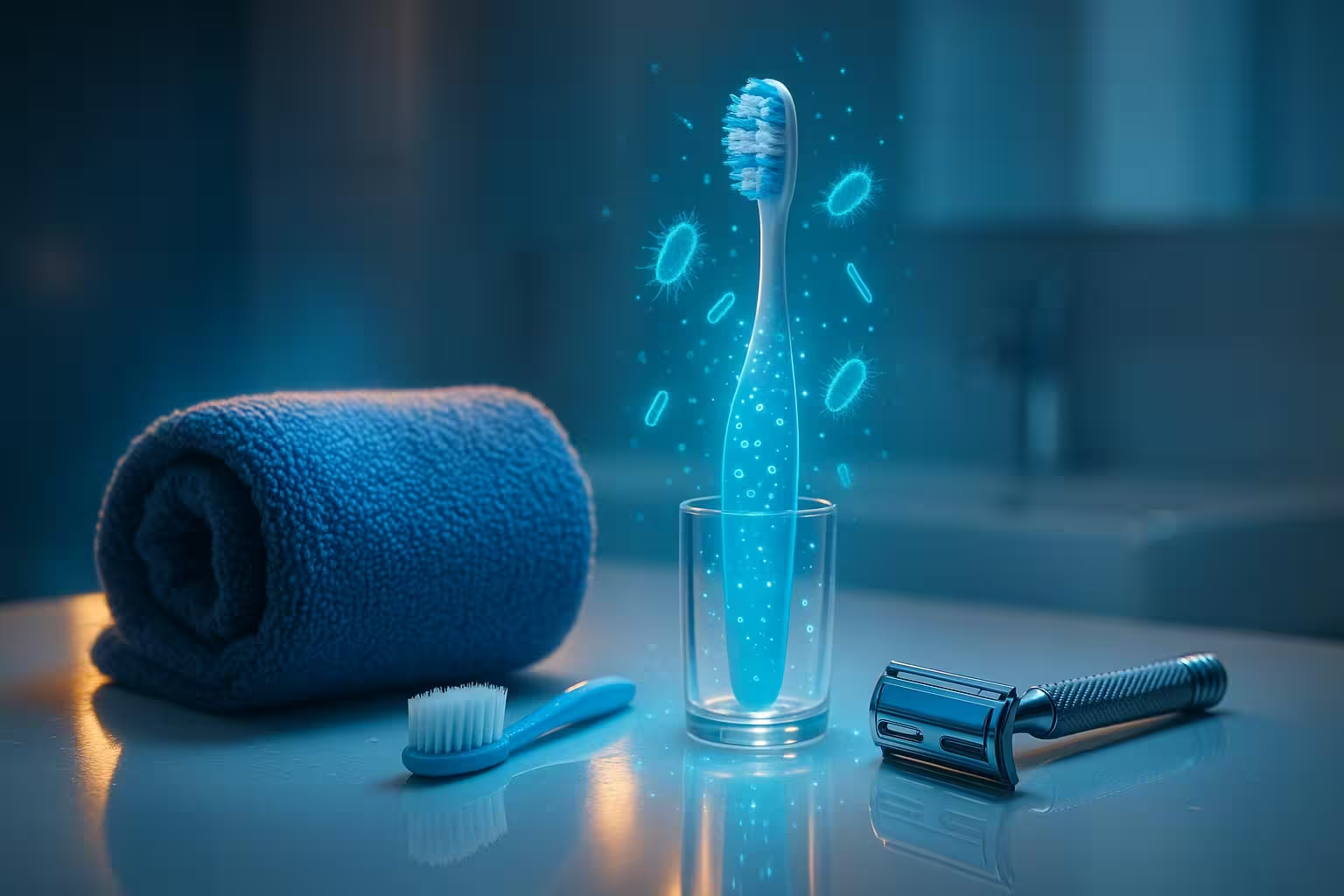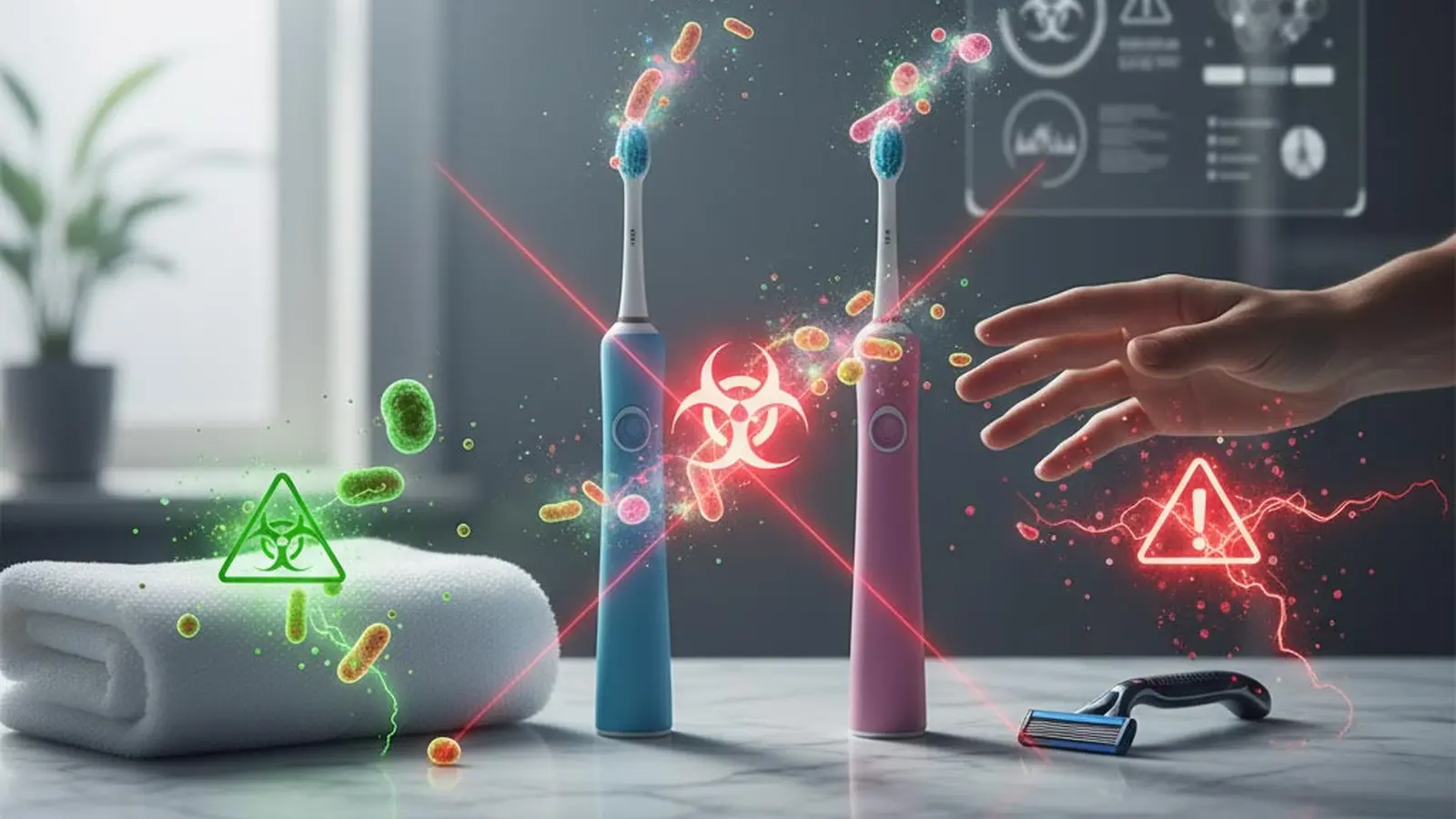6 Minutes
Why you should be cautious about sharing bathroom items
When traveling or staying away from home it can be tempting to borrow a towel, razor or toothbrush. Microbial science and epidemiological studies suggest that sharing these everyday bathroom items can transfer pathogens — bacteria, viruses and fungi — that survive on fabrics, plastics and metals for hours to months. While the absolute risk on a single occasion is often low, repeated or routine sharing raises the chance of colonisation or infection, and may expose people to antibiotic-resistant strains that are harder to treat.
Scientific background: how long pathogens survive on surfaces
Laboratory studies that measure pathogen survival on materials show wide variation depending on organism and surface. Some fungi such as Aspergillus can remain viable on cloth and plastic for more than a month. Certain bacteria, including some Staphylococcus species, can persist for months or even years on dry surfaces. Many respiratory and herpesviruses survive for hours to days on surfaces, while non-enveloped viruses and those protected by organic residue on objects may persist longer.
These survival data come from controlled environmental experiments that vary temperature, humidity and material type. Real-world transmission also depends on host factors (skin breaks, immune status), frequency of contact and the microbial dose transferred. Randomised controlled trials that deliberately expose people to used personal items are ethically impossible, so most human evidence comes from observational outbreak reports and household transmission studies.
Item 1: Towels — a skin-infection vehicle
Towels create warm, moist microenvironments that can retain skin microbes after use. Observational studies show an association between sharing towels and transmission of skin infections. For example, an outbreak investigation among adolescent contact-sport players found that individuals who shared towels were significantly more likely to develop antibiotic-resistant Staphylococcus aureus infections. In a separate household study, families that shared towels had higher intra-household spread of Staph infection.
Staphylococcus aureus can cause impetigo (a superficial skin infection) and, rarely, invasive disease such as sepsis if it enters the bloodstream through cuts or abrasions. Players who have cuts, grazes or frequent skin friction are particularly vulnerable. Washing with soap reduces surface microbes but does not sterilise skin; therefore regular sharing of damp towels increases cumulative exposure risk.
Item 2: Toothbrushes — blood and saliva risks
Toothbrushes contact saliva and can abrade gums, producing microscopic bleeding that creates a direct route for blood-borne pathogens. Studies have isolated potentially pathogenic bacteria such as Staphylococcus, Escherichia coli and Pseudomonas from used toothbrushes. Herpes simplex virus type 1 (HSV-1) and other viruses have been shown to survive on plastic bristles for days under favourable conditions.
Sharing a toothbrush can therefore transfer HSV-1 (cold sores), Epstein–Barr virus (glandular fever), and — in rare but documented cases — blood-borne viruses such as hepatitis C if contaminated blood is present. Many people infected with hepatitis C are asymptomatic and unaware of their status, increasing the risk of unintentional transmission via shared oral hygiene items.

Item 3: Razors — cuts, blood and human papillomavirus
Razors are high-risk because they frequently nick the skin and may carry both visible and invisible blood. Human papillomaviruses (HPV) that cause common warts and other cutaneous lesions can survive on inanimate objects and have been implicated in transmission via shared grooming tools. Razors can also transmit other blood-borne agents if contaminated.
Dermatologists and infection-control specialists typically recommend each person maintain their own razors and avoid sharing to reduce the risk of cross-transmission of skin pathogens and blood-borne infections.
Who is most at risk?
Certain groups are more susceptible to infection from shared bathroom items: people with broken skin (cuts, abrasions), those with weakened immune systems (infants, older adults, patients on immunosuppressive medication), and people with chronic conditions such as poorly controlled diabetes that impair immune cell function. Athletes and others with frequent skin trauma or heavy sweating are also at higher risk of acquiring skin infections from contaminated fabrics and personal items.
Practical advice and prevention
To reduce transmission risk, follow practical hygiene steps: avoid sharing towels, razors and toothbrushes; store personal items separately; launder towels and washcloths at high temperatures and dry thoroughly; replace toothbrushes every 3 months or after illness; use single-user disposable razors or regularly replace razor heads; allow hard items to dry between uses and clean handles and holders routinely with an appropriate disinfectant.
For travellers, pack a compact towel and a travel toothbrush/razor to avoid borrowing. If borrowing is unavoidable, choose a fresh, dry towel or new razor blade and avoid direct skin contact with used oral care items.
Expert Insight
"Surface survival of microbes is variable, but the principle is simple: objects that contact mucus membranes or broken skin amplify risk," says Dr. Sarah Mitchell, infectious-disease clinician and lecturer in public health. "Routine non-sharing of toothbrushes, razors and towels is a low-cost, high-benefit habit. In settings with vulnerable people — neonates, older adults, transplant recipients — strict personal-item policies can prevent serious outcomes."
Conclusion
Scientific evidence from laboratory survival studies and outbreak investigations indicates that towels, toothbrushes and razors can transmit pathogens under realistic conditions. While an occasional, single exposure to a loved one's item may carry low risk, routine sharing increases the probability of colonisation and infection, including antibiotic-resistant strains and blood-borne viruses. The safest approach is to treat these personal hygiene items as individual-use only, practise thorough laundering and replacement, and prioritise avoidance of sharing in households with vulnerable people.
Source: theconversation


Leave a Comment